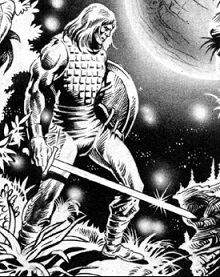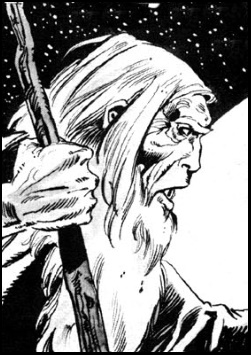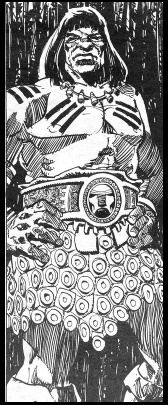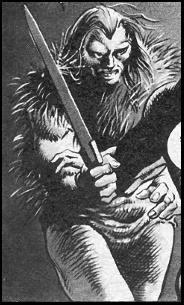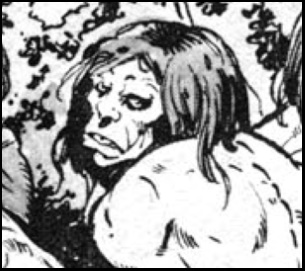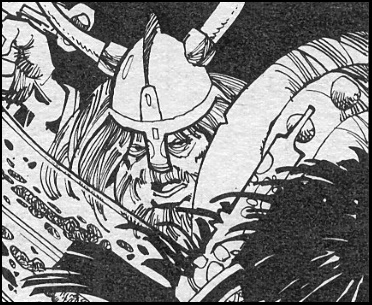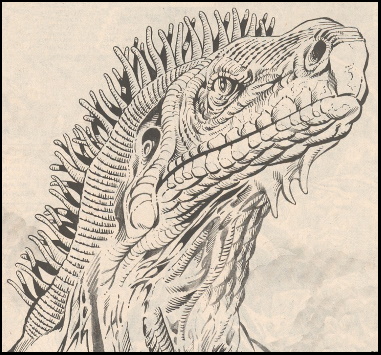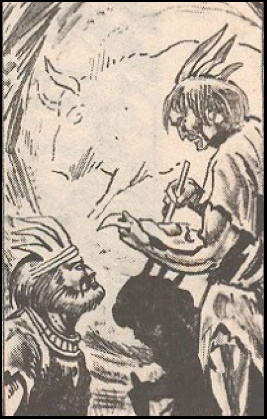Comments: Created by Robert Ervin Howard.
Adapted for Marvel Comics by Roy Thomas, Barry Windsor-Smith and Tim A. Conrad.
The history of tectonic drift and geophysical configuration of
continents on Marvel Earth is nearly identical to the real world
(Adventures of the X-Men#12, 1997), but diverged at some point,
resulting in the radically different continents of the Pre-Cataclysmic
Age and the Hyborian Age.
- King Kull once stated that "Valusia was old
when the peaks of Atlantis and ancient Mu were but the isles of the
sea... the land I now rule was once lorded over by the the terrible
Serpent-Men" (Marvel Preview#19, 1979), thus Atlantis and Mu arose
from the ocean depths sometime after Sligguth created the Serpent Men
"approximately 1 million years BC" (Marvel Zombies: The Book of Angels,
Demons, & Various Monstrosities: Set, 2007).
- Lemuria was depicted
on a map as part of the "pre-cataclysmic continent of Mu" (Official
Handbook of the Marvel Universe: Deluxe Edition#7: Lemuria, 1986), "in
the distant past, it was part of the continent Mu" (Marvel Atlas#1:
Lemuria (Deviant), 2007), and Thongor dwelled in prehistoric Lemuria
"half a million years ago" (Creatures on the Loose#24, 1973).
- Therefore, Atlantis, Mu and Lemuria arose sometime between one million
to five hundred thousand years ago.
- The event that led to the
organization of the pre-Cataclysmic continents was unknown, but Queen of the Black Coast
(1934) by Robert E. Howard suggested a polar shift occurred, as
"somewhere on the planet the magnetic centers were shifting; the great
glaciers and ice-fields were withdrawing toward the new poles,"
although this was not mentioned in its adaptation in Conan the
Barbarian#100, 1979.
- A polar shift, however, did occur on Marvel Earth
"500,000 years ago" (Fantastic Four I#221, 1980).
- Thus it is possible
a polar shift or some other event caused the continents to take on the
configuration they held in the Pre-Cataclysmic Age (c. 100,000-18,000
BC), forcing Atlantis, Lemuria and Mu to arise from the oceans, North
America to submerged with only its mountain ranges forming a chain of
islands, and the geotopography of the remaining continents to alter.
- During the Pre-Cataclysmic Age, Africa was known as Alkebulan (Black
Panther VI#5, 2016), Antarctica as Pangea (Blockbusters of the Marvel
Universe, 2011), Australia as the Nameless Continent (Savage Sword of
Conan I#7: The Hyborian Age, Chapter 1 - The Pre-Cataclysmic Age,
1975), Eurasia (Europe and Asia) as Thuria (Marvel Graphic Novel#42,
1988) or the Thurian Continent (Kull the Conqueror I#2, 1971), North
America as the Pictish Isles (Kull the Conqueror I#2, 1971), the
Pictish Islands (Savage Sword of Conan I#7: The Hyborian Age, Chapter
1 - The Pre-Cataclysmic Age, 1975) or the Isles of Sunset (Savage Sword
of Conan I#38: A Gazetteer of the Hyborian World, Part VI, 1979), and
South America as the Southern Continent (Savage Sword of Conan I#104/2,
1984).
- The other continents were Atlantis (Motion Picture
Funnies Weekly#1, 1939), Lemuria (Sub-Mariner#10, 1969) and Mu
(Namora#1/2, 1948).
- The Great Cataclysm (c. 18,000 BC) caused
Atlantis, Lemuria and Mu to submerge beneath the oceans again, North
America to arise, and the geotopography of the remaining continents to
again alter.
- During the Hyborian Age (c. 14,000-9500 BC), Africa was
known as Kush (Conan the Barbarian I#58, 1976), Antarctica as the
Frozen Land (Conan the Savage#2/2, 1995) or the Great Isle of Ice
(Conan the Savage#3/2, 1995). Australia as the Unknown Land (Savage
Sword of Conan I#193, 1992), Eurasia (Europe and Asia) as Thuria
(Blockbusters of the Marvel Universe, 2011) or the Mainland (Marvel
Graphic Novel#42, 1988), North America as Novum Terra (Savage Sword of
Conan I#166, 1989), and South America as Terra Incognito (Savage Sword
of Conan I#166, 1989). Afterwards, the Post-Hyborian Cataclysm (c.
8000 BC) apparently shifted the geotopography one final time, restoring
the continents to the modern configuration (Mystic Arcana: The Book Of
Marvel Magic: Tribe of the Moon, 2007).
- The
Briton warrior Cororuc was active during the first century BC, as he stated the
Celts arrived in Britain "over five hundred years ago" (The Lost
Race), with the historic Celts arriving around the sixth century BC. Cororuc
could only be aware of the historic appearance of the Celts, not the much
earlier version mentioned by Robert E. Howard, who arrived thousands of years
before during the Pictish migration.
The continent of Thuria during the Hyborian Age was commonly depicted
as a supercontinent composed of Africa, Asia and Europe together, but
on occasion the African continent was referred to as a separate
continent of Kush, despite Kush actually only being one of the
northernmost of the Black Kingdoms. Robert E. Howard, in correspondence
to P. Schuyler Miller dated March 10, 1936, addresses this: "Concerning
Kush, however, it is one of the black kingdoms south of Stygia, the
northern-most, in fact, and has given its name to the whole southern
coast. Thus, when an Hyborian speaks of Kush, he is generally speaking
of not the kingdom itself, one of many such kingdoms, but of the Black
Coast in general. And he is likely to speak of any black man as a
Kushite, whether he happens to be a Keshani, Darfari, Puntan, or
Kushite proper. This is natural, since the Kushites were the first
black men with whom the Hyborians came in contact - Barachan pirates
trafficking with and raiding them."
CONTINENT NAMES
|
Modern Age
|
Hyborian Age
|
Pre-Cataclysmic Age
|
Africa
|
Kush
|
Alkebulan
|
Antarctica
|
Frozen Land
|
Pangea
|
Australia
|
Unknown Land
|
Nameless Continent
|
Eurasia (Europe/Asia)
|
Thuria
|
Thuria |
North America
|
Novum Terra
|
Pictish Islands
|
South America
|
Terra Incognito
|
Southern Continent
|
| Atlantis (submerged)
|
Atlantis (submerged)
|
Atlantis |
| Lemuria (submerged)
|
Lemuria (submerged) |
Lemuria |
| Mu (submerged)
|
Mu (submerged) |
Mu |
The Cimmerian people of Cimmeria, from which the warrior Conan was
sired, were descended from survivors of Atlantis who fled to western
Thuria during the Great Cataclysm (Savage Sword of Conan I#12: The Hyborian Age, Chapter 3 - The Hyborian
Kingdoms; The Hyborian Age), and possibly the related remnant Atlanteans (Savage Sword of Conan I#104/2 (fb) - BTS; Men of the Shadows - BTS), who interbred with the elder Cimmerian race indigenous to
western Thuria (Savage Sword of Conan I#31: A Gazetteer of the
Hyborian Age, Part II: Cimmeria; Conan of the Isles), who had once been tormented by Shuma-Gorath, but saved by the god Crom prior
to the Great Cataclysm. The union of both their cultures resulted
in the birth of the Cimmerian race during the Hyborian Age, which later
gave rise to the Gaels, ancestors of both the Irish and Highland
Scotch.
Humans (homo sapiens) began appearing circa 300,000 BC in the real
world, but upon Marvel Earth, a number of humans (and even mutants)
began to manifest as early as circa one million BC (Marvel Legacy#1,
2017), including Prehistoric Avengers members Ghost Rider (Ghost),
Phoenix (Firehair) and Starbrand (Vnn). The proliferation of early
humans may have been due to the Horde-infected Celestial the Progenitor
arriving on Earth circa four billion BC (Avengers VIII#5, 2018) or the
Celestial First Host circa one million BC (Eternals I#1, 1976). The
Picts's earliest chronological reference is circa 110,000 BC, as the Pict
chieftain "Gorm had behind him a heritage of a hundred thousand years
of screaming savagery" (The Hyborian Age)
and he lived circa 9500 BC.
The Pre-Cataclysmic Age began "about 100,000 years ago" (Handbook of
the Conan Universe#1: Atlantis and the Pre-Cataclysmic Age). Kull
stated "The feud between Atlantean and Pict is older than the world"
(Savage Sword of Conan I#197/2, 1992). Valka, the "alleged son of the
Earth goddess Gaea" (Official Handbook of the Marvel Universe A To
Z#14: Zhered-Na, 2010), was worshipped since "around 30,000 B.C."
(All-New Official Handbook of the Marvel Universe A To Z#3: Council of
Godheads, 2006). The alliance between the Pictish Isles and Valusia
began circa 19,500 BC, as it stood "for a thousand years" (Savage Sword
of Conan I#2/2, 1974) circa 18,500 BC.
The Pictish Isles of the Pre-Cataclysmic Age was strongly implied by
Robert E. Howard to be the submerged continent of North America.
Despite never explicitly stating this fact, he left numerous details in
his works pointing to that fact. In The Hyborian Age, he wrote "Then
the Cataclysm rocked the world... and the Pictish Islands were heaved
up to form the mountain peaks of a new continent." In Men of the
Shadows, Gonar told the Norseman, "Far, far across the great, wave
tossed vastness of the Atlantic lie two great continents, so vast that
the smaller would dwarf all Europe... So mighty are these continents
that they span the world, from the snows of the north to the snows of
the south. And beyond them lies a great ocean, the Sea of Silent Waters
[the Pacific Ocean]. Many islands are upon that sea, and those islands
were once the mountain peaks of a great land – the lost land of
Lemuria. And the continents are twin continents, joined by a narrow
neck of land. The western coast of that northern continent is fierce
and rugged. Huge mountains rear skyward. But those peaks were islands
upon a time, and to those islands came the Nameless Tribe [the Picts],
wandering down from the north, so many thousand years ago that a man
would grow a-weary numbering them. A thousand miles to the north and
west had the tribe come into being, there upon the broad and fertile
plains close by the northern channels, which divide the continent of
the north from Asia... Then, upon a day, a mighty earth-quake rocked
the world. Sky mingled with sea and the land reeled between. With the
thunder of gods at war, the islands of the west plunged upward and
lifted from the sea. And lo, they were mountains upon the new-formed
western coast of the northern continent." In the Marvel Universe, this
was confirmed in the Great Cataclysm entry in Blockbusters of the Marvel Universe, 2011.
As the Pictish Isles and North America were one and the same, the Picts
and the Paleo-Americans were probably either the same peoples or
related, despite this never being confirmed by Howard. Both races
migrated across Beringia from Asia to North America and occupied the
same landmasses during the same periods of prehistory. During the
Hyborian Age, Conan mentioned that "a race of warriors called Picts --
savages who hid in trees, used arrows like these, and killed
silently,
in darkness" (Savage Sword of Conan I#167), referring to the Malagu
tribe of Novum Terra. On the hypothesis that the real world history of
the Paleo-Americans and their settlement of North and South America
parallel the Earth-616 history of the Picts during the Pre-Cataclysmic
and Hyborian Ages, it would appear the original Paleo-Americans or
Nameless Tribe began their migration (Savage Sword of Conan I#104/2,
1984) circa 110,000 BC, from northeastern Thuria (Asia) across Beringia
to move southward and colonize the Pictish Isles (North America) as the
Picts and the Southern Continent (South America) as perhaps a
proto-Inka people (Savage Sword of Conan I#104/2, 1984). After the
Great Cataclysm, most of the Picts were decimated (once mistakenly
believed to have destroyed their entire population) as the Pictish
Isles arose to become Novum Terra, but after a few centuries many of
the survivors undertook a thousand year journey to rejoin their
brethren (Savage Sword of Conan I#104/2, 1984) who dwelt within the
Pictish colony in western Thuria (Europe). The remaining Picts in Novum
Terra eventually merged with still more Paleo-Americans migrating
across Beringia during the Hyborian Age, forming new cultures such as
hunter tribes of the Chuma, Malagu and Shuta (Savage Sword of Conan
I#167, 1989), and much further north the fur-clad hunters of Inupak's
tribe (Savage Sword of Conan I#168, 1989). The continent also became
inhabited by at least three Atlantean colonies, Mayapan, Poseidonis and
Zothique (Marvel Graphic Novel: Conan of the Isles, 1988, Conan
Saga#95: The Conan Comics Chronology, Chapter Seventeen, 1995), as well
as
the aforementioned Men of the Sea (Savage Sword of Conan I#104/2,
1984). The
Southern Continent was also gravely affected by the Great Cataclysm to
become Terra Incognito, but the remnants of the proto-Inka culture
eventually merged with more Paleo-Americans migrating southward from
Beringia during the Hyborian Age, forming new cultures such as the Inka
people dwelling in the city of Kuzko (Savage Sword of Conan I#166,
1989). There is evidence that during the Hyborian Age, the cultures
that remained in Novum Terra and Terra Incognito may have drifted away
from the Pictish pantheon towards other gods. The Inka people of Terra
Incognito worshipped "Pathakamak" (Savage Sword of Conan I#166, 1989),
which was etymologically similar to the Quechua term Pacha Kamaq, a
creator deity of the Apu or Incan gods of South America. The Shuta
tribe of Novum Terra worshipped the "coyote-spirit" (Savage Sword of
Conan I#167, 1989), who was similar to the coyote god Nanabozho, a
trickster deity of the Manidoog gods of North America. After the
Post-Hyborian Cataclysm shifted the continents to their modern
configuration "circa 8,000 BC" (Mystic Arcana: The Book of Marvel
Magic: Tribe of the Moon, 2007), Novum Terra became North America and
Terra Incognito became South America, and the Paleo-Americans gradually
developed into the Native Americans or Indigenous peoples of the
Americas.
Robert E. Howard wrote two differing accounts of the history of the Picts from
the Pre-Cataclysmic Age to the Hyborian Age, both providing
contradictory details in the narrative. In Men of the Shadows and The Lost Race, the
Picts were decimated but not eradicated when the Pictish Isles arose to
become a new continent during the Great Cataclysm, they were driven to
migrate to other continents including Atlantis, which had not yet
submerged, and degenerated into savagery because of interbreeding with
the Reindeer Men. In The Hyborian Age, the Picts were utterly
annihilated when the Pictish Isles arose and the only survivors were
from the Thurian colony, Atlantis had submerged due to the Great
Cataclysm, and their descent into savagery was a result of a five
hundred year war with the Atlantean refugees. This combined history
attempted to reconcile the two variant histories, with the Picts
surviving both with the Thurian colony and the arisen Pictish Isles,
albeit with a declined number, Atlantis had submerged but remnants of
the island remained above the surface, both branches of the Pictish
people eventually reunite, and their descent into savagery was brought
about first by the war with the Atlantean refugees, and then
exacerbated by the interbreeding with the Reindeer Men. Also, Men of
the Shadows stated that the Picts arrived at the Middle Sea or
Mediterranean Sea (also called the Inland Sea in The Lost Race) after the Great Cataclysm, but The Hyborian Age
indicated that during the Hyborian Age, the area where the
Mediterranean stood was all land and it did not become the
Mediterranean Sea until after the Hyborian Age. As a compromise, we
determined the Picts first arrived at the Middle Sea sometime after the
Great Cataclysm, the sea later drained by the Hyborian Age to reveal
the lands of Argos, Koth and Shem, only for it to again flood as the
Mediterranean Sea following the Post-Hyborian Cataclysm.
The third century Gonar appeared in Kings of the Night and Worms of the
Earth. An unidentified "wizard" who fulfilled a role similar to Gonar was in
Men of the Shadows, and was confirmed as being Gonar in Legion From the
Shadows. He was born circa 104 AD, as he was "more than a hundred
years" (Savage Sword of Conan I#103/2) and "outlived a hundred years"
(Men of the Shadows) in 205 AD, and again "outlived a hundred years"
(Legion From the Shadows) in 208 AD. He would have been around 24 years
old after the battle with the 9th Legion in 128 AD, where he was
described as "old Gonar" and "the old wizard" (Legion From the
Shadows); it is possible that Gonar aged unnaturally upon becoming a
shaman, or this could even be his predecessor, also named Gonar. The
bloodline of Gonar was shamans that used their magicks to assist both
Pictish rulers and heroes and their allies. It appeared that perhaps
one male each generation of the Gonar bloodline was named Gonar, who
was taught all the accumulated wisdom and shamanistic magic of the
preceding Gonars, from at least the late Pre-Cataclysmic Age to the
eleventh century. There were at least four Gonars depicted, including
Gonar of the Pre-Cataclysmic Age (Kings of the Night), Gonar of the
Hyborian Age (Conan: The Ravagers Out of Time, 1992), Gonar of the
third century (Kings of the Night), and Gonar of the eleventh century
(The Dark Man). A false "Gonar," a sorcerer of the Black Ring and ally
of Thoth-Amon, also appeared in Conan the Barbarian I#68, 1976. As
each Gonar appeared ancient and shared the same name, it was rumored
there was only one Gonar and he was in truth immortal. In Legion From
the Shadows, Gonar of the third century stated "I am directly descended
from that Gonar who was the greatest sorcerer in the days of Kull of
Atlantis, king of Valusia. And though a hundred thousand years and a
thousand fathoms of sea have swept Valusia into forgotten myth, there
are fewer links in the chain of my ancestry than common minds could
grasp. I am old, Bran — I have outlived a hundred years. I have been a
priest of the Serpent, the Moon and the Shadow; now I am high counselor
to the first acknowledged king of Pictdom in five hundred years. My
brain holds the secrets of elder lore and hidden knowledge that would
drive other minds into gibbering oblivion. But for these years and for
this wisdom I have had to pay a price."ETHNIC
VARIATIONS IN PICTS
"Noble"
Picts - The core ethnicity and culture of the Pictish people, they initially
settled the Pictish Isles after crossing the Bering land bridge circa 110,000
BC. When the Great Cataclysm caused the isles to become the volcanic western
mountain range of Novum Terra circa 18,000 BC, they were almost wiped out, but
the survivors became nomadic for a time, first settling in the eastern valleys
of Novum Terra for centuries, then spending the next thousand years migrating
from Terra Incognito, Atlantis, the west coast of Kush, and areas of western
Thuria. Eventually driven forth by the advancing Kelts, they reunited with the
"savage" Picts, who prior to the Great Cataclysm had established a
colony on Thuria, and following an aggressive war with Atlantean refugees and
interbreeding with the Reindeer Men, had degenerated to become smaller and more
brutish in stature and temperament over the millennia.
The numerically superior
"savage" Picts acknowledged the authority of their "noble"
brethren, who themselves ensured they would keep their bloodline pure and only
marry other "noble" Picts. Both would would unite and settle the
Pictish Wilderness during the Hyborian Age, and following the Post-Hyborian
Cataclysm circa 8000 BC, resettle Caledon upon the British Isles as the
Caledonian Picts. They would dwell there as a distinct society until the ninth
century, but in secret until at least the early 11th century, and there are
rumors they still existed in secret by as late as the early 20th century.
"Savage"
Picts - A colony of "noble" Picts was formed in Valusia, western
Thuria towards the end of the Pre-Cataclysmic Age, but when the world was
devastated by the Great Cataclysm circa 18,000 BC, the Pictish colony remained
relatively untouched. However, refugees from Atlantis escaped to the mainland,
and aggressions broke out between the ancestral enemies. Five hundred years of
brutal warfare reduced both to little more than bestial savages, made worse
with the Lesser Cataclysm circa 17,500 BC. These Picts were eventually driven
forth by the Kelts to the remote north and west mountains and again encountered
the Reindeer Men, redbearded neanderthal giants, with whom they interbred,
causing them to degenerate as ages passed, becoming smaller and more brutish in
stature and temperament over the millennia.
Reunited with the "noble"
Picts, who had gradually migrated from Novum Terra following the Great
Cataclysm, the numerically superior "savage" Picts acknowledged the
authority of their "noble" brethren. Both "noble" and
"savage" Pict would unite and settle the Pictish Wilderness during
the Hyborian Age, and following the Post-Hyborian Cataclysm circa 8000 BC,
resettle Caledon upon the British Isles as the Caledonian Picts, and they would
dwell there as a distinct society until the ninth century, but in secret until
at least the early 11th century, and there are rumors they still existed in
secret by as late as the early 20th century.
Alban
Picts - After more than a millennium following the Great Cataclysm, the
"noble" Picts had settled within western Thuria for centuries,
resettling for a time in the lands later known as Cornwall. Eventually these
Picts were driven forth by the advancing Kelts, but a handful swore to never
abandon their lands and took refuge in the caves and tunnels beneath the
ground. Within the caves they found and within the caves they constructed,
these Alban Picts would eventually assume a diminutive stature, the tallest
standing no more than four feet in height, and sitings of them would be attributed
to elves and dwarves of legend.
Zingarans
- Sometime following the Great Cataclysm, a tribe of Picts conquered the Valley
of Zingg, settling amongst a people akin to the Shemites who had previously
settled there, and they in turn were conquered by a roving Hyborian tribe. From
the mingled elements of this multiracial people arose the kingdom of Zingara,
an advanced agricultural culture, during the Hyborian Age. Zingara was
conquered by Aquilonia circa 9500 BC, but after the fall of Aquilonia, the Pictish
Empire invaded Zingara, and thousands of Zingarans fled eastward to the mercy
of the advancing Hyrkanians, who resettled the refugees into Zamora as
subjects. When Cimmerians destroyed the ancient Hyrkanian kingdom of Turan, the
power of the eastern conquerors broken before the invading Cimmerians and
Nordheimr, the Hyrkanians herded their subjugated captives as they rode back to
the mysterious east. With their retreat went thousands of Zamorians and
Zingarans, who eventually settled together far to the East, and from their
intermarriage the Romani (also known as the Gypsy) people were born. (Note: As
real world genetic research indicates that Romani people probably originated in
India, the land "far to the East" [The Hyborian Age] where they were
resettled was probably Vendhya.)
Etruscans
- Descendants of an admixture of Pictish, Hyrkanian and Stygian bloodlines, the
Etruscan culture of ancient Italy arose around 900 BC, thrived in the territory
later known as modern Tuscany, northern Lazio and western Umbria, having
originally dwelt in ancient Koth. They were influenced by ancient Greek culture
circa 750 BC, and began assimilation into Roman society in the late 4th century
resulting from the Roman–Etruscan Wars, and the Etruscans territory was incorporated
into the newly established Roman Empire in 27 BC.
Pictish isles and Tribes:
For the Pictish Isles of the Pre-Cataclysmic Age, the island Tathel and
tribes Borni, Dano, Nargi, Red Isle, Sungara, Tatheli, Whale-Slayers
and Wolf-Slayers were from Wizard and Warrior;
and the island Kurmonn and
tribe Hawkmoons from Kull and the Barbarians#2, 1975.
For the Hyborian
Age, the Gwaweli tribe was from Savage Sword of Conan I#26-27, 1978;
the Eagle and Wolf tribes from Savage Sword of Conan I#47, 1979; the
Cormorant, Eagle, Hornbill, Sea-Falcon and Sharks' Teeth tribes from
Savage Sword of Conan I#48, 1980; the Hawk, Turtle, Wildcat and
Wolfmen tribes from Savage Sword of Conan#76/2, 1982; the Hawk, Raven,
Sea-Land,
Wildcat and Wolf tribes from Handbook of the Conan Universe#1, 1986;
the Oranadi and Tantaka tribes from Savage Sword of Conan#135, 1987;
the Btoth tribe from Savage Sword of Conan I#137, 1987; the Ktonpha
tribe from Savage Sword of Conan I#138, 1987; the Raven tribe from Savage Sword of Conan#201, 1992; and the
Snow-Lion tribe from Savage Sword of Conan I#219/2, 1994.
For the third century, the Wolf tribe was from Kings of the Night, and
the Raven tribe from Legion From the Shadows.
In the
comics they have been shown with pink skin, red skin and brown skin.
Although unidentified specifically, spending 90,000 years on the Pictish Isles
alongside indigineous Americans, all of who crossed over from the Bering Land
Bridge, I think they qualify as Paleo-Americans. Even when in Britain, the
Noble and Alban Picts did not breed with outside races, and the Savages only
bred with the Reindeer Men. Even in real life, scientists aren't exactly sure
what the Picts were. I would suggest, "swarthy skinned" but not more
than that
In Conan the Barbarian I#68, 1976, the Hyborian Age sorcerer Karanthes
summoned a blood red jewel from the mists of time to give to Conan, who
shortly thereafter encountered Kull, who had been displaced in time
along with the City of Wonders. Conan gave him the jewel, which was
revealed by Kull to have vanished from his crown when the City was
displaced by a demonic impostor of "Gonar," and the City returned to
the Pre-Cataclysmic Age shortly thereafter. Perhaps this is the same
blood red jewel Kull later gifted to Brule, which later was passed down
to Bran Mak Morn and allowed Gonar to transport Kull to the third
century.
The Bran Mak Morn story The Dark Man was
never directly adapted into
Marvel Comics, but was freely adapted as a Conan story in Savage
Tales#4, 1974. Conan replaced Turlogh Dubh O'Brien, Mala replaced
Moira, and
the Dark God (an apotheosized Brule) replaced the Dark Man (an
apotheosized Bran). Other characters (Brogar, Thorfel the Fair) and
locations (Isle of Swords) may have similar names, but are distinctly
separate between the Hyborian Age and the eleventh century.
Brule the Spear Slayer (Savage Tales#4, 1974) and Bran Mak Morn (The
Dark Man) were both deified by the Picts upon their deaths, worshipped
as deities. It was unrevealed if either was truly apotheosized as
a god, but the effigies of both, Brule as the Dark God and Bran as the
Dark Man, possessed supernatural characteristics. Either may be
considered one of the Pictish pantheon of gods. Brogar of
the eleventh century stated the Dark Man was "the only God we have
left" (The Dark Man), and Brogar of the Hyborian Age also stated the
Dark God was "the only God we have left" (Savage Tales#4, 1974). An
ancestor or two of Brule and Bran may also have been honored as gods,
as there was "a legendary hero or two, semi-deified for feats of
personal strength or whole sale murder" (Wizard and Warrior).
Chronicle of the Black Labyrinth was written as a supplement for the
roleplaying game Werewolf: The Apocalypse. There were many aspects of
the story that somewhat contradict established details of the Howard
story, primarily with Bran (called Brennus therein but confirmed as
Bran Mak Morn later in the book) being a werewolf and the Worms of the
Earth being aspects of the Wyrm, a power of entropy. However, the issue
can be reconciled with Titus Germanicus seeing Bran appear as his wolf
totem during battle, something similar happening when Bran battled
Gonar (Men of the Shadows), and Titus incorrectly assuming he was a
werewolf, and Bran, who sought his alliance, indulged Titus' erroneous
assertions about the supernatural. There was also the seeming
contradiction of Bran turning against the Gaels and seeking an alliance
with Rome, but at this time during the Roman invasion of Caledonia
(208-210 AD), Septimius Severus personally led the Roman forces north
to Hadrian's Wall, forcing many of the Caledonian tribes to try to
reach a peace agreement with Severus for fear of genocide by the
Romans. In Legion From the Shadows, Bran considered ending the alliance
with the Gaels, feeling the Pictish forces he now commanded able to
oppose Rome, as he stated "We are an army of Picts! A victory today
will prove to all Britain that Pictish savages can defeat the Roman
colossus — defeat Rome without Celtic allies, without ensnaring
sorceries! That will be a victory, Gonar! Pictish valor and Pictish
steel will win that victory — and then shall the Celtic tribes look to
Pictdom for leadership!"
Howard was influenced by the writings of Madame Blavatsky (Helena
Blavatsky), a Russian philosopher and author. Blavatsky advocated the
idea of "Root Races" in her book The Secret Doctrine, 1888, in which
ancient human races existed on lost continents. Howard adapted her
concept to his own fictional writings, with the First Race (Pict),
Second Race (Lemurian), Third Race (Atlantean) and Fourth Race (Kelt).
The Men of the Sea, also known as the Second Race or Lemurians (Men of the Shadows)
of Lemuria were reptilian humanoids and could survive for hours beneath
the waters. Despite Howard describing the Picts, Atlanteans and Kelts
as being human, the Men of the Sea were described by Howard as "half-human" (Men of the Shadows). In the
Marvel Universe, perhaps they were a Deviant branch or a genetically
modified mutate engineered by the Deviants. The Atlanteans, also known
as the Third Race, were probably from a remnant of Atlantis that
remained above water, as the Atlantis mainland submerged during the
Great Cataclysm (The Hyborian Age).
Both they and the Atlantean refugees who fled to Thuria following the
Great Cataclysm probably were ancestor to the Cimmerians. The
Pre-Cataclysmic Celts were called the Fourth Race (Men of the Shadows) and the Kelts (Brachan the Kelt by Robert E. Howard, 1981)
and were the ancestors for the later Celtic people of later recorded
history. Brule, from the late Pre-Cataclysmic Age, inherited his volcanic blue
eye color from a Celt or possibly Thulian ancestor (Wizard and Warrior).
The unseen Roman Emperor during the battles of Bran
Mak Morn was not identified by Howard, but was revealed as Septimius
Severus, who reigned
from 193 to 211 AD, in For the Witch of the Mists and Legion From the
Shadows. Severus would have probably also been the same Roman Emperor
that time traveler Tommy Tyme encountered in "200 A.D" (Young Allies
Comics#14/2, 1944).
In Bizarre Adventures#25, 1981, Lady Megan Daemon
of the Clan Daemon described her ancestry in Scottish Highlands, noting how
that location held dark power and how the Daemon family had always held
a part of it. "Before the MacKay, Sutherland, Sinclair, before Danes
and Gaels and
Picts, before the Lairds of Alban -- from a time when the dark
Caledonian forests covered the moors -- we were! And we were feared."
She also mentioned the "Daemon isn't my family's original name, but a
Roman corruption of it." If her family predated the Picts in the lands
now known as Scotland, they must have been there at least a few
centuries before the Great Cataclysm between circa 18,500 BC to 18,000
BC, when the first Pictish colony was founded in Valusia.
The Black River was called Yaba Nutchi in the Pictish language (Conan the Barbarian I#136, 1982).
The dates of the Cormac Mac Art
adventures and related Arthurian legends were either the late fifth or early
sixth century. The Night of the Wolf has Uther Pendragon the king of the
Damnoni, with Arthurian tradition having Uther a king during the late 5th
century. Tigers of the Sea was "about eighty years" after
Alaric led his Visigoths during the Sack of Rome in 410 AD, placing the story
circa 490 AD, and Cormac first battled Gaelic warriors "some fifteen
years" before this story, so he likely has been a reaver since at least
before circa 475 AD. Also the Moon amulet stolen from the Picts was stolen
"a generation" before the abduction of Helena, so circa 470 AD. The
Temple of Abomination mentioned that Arthur Pendragon (traditionally the
son of Uther, although Cormac and Wulfhere do not believe this) was now a king,
and allied with Gawain and Lancelot, which would place it after the reign of
Uther, but the reference to it as "fifty years" after the Sack of
Rome, placing the story in 460 AD, placed it much too early and is probably
incorrect. Note that Howard's references to Vikings are anachronistic, as
Vikings existed from the late 8th to late 11th centuries, but there were Saxon
pirates during this time, who were in a way prototypical Vikings. Historia
Regum Britanniae stated that the Battle of Camlann and the death of Arthur
were in "the five hundred and forty-second year of our Lord's
incarnation" or 542 AD, although Annales Cambriae placed it around
537 or 539 AD. As the Western Roman Empire fell in 476 AD, the Roman Empire
that Arthur warred with may have been the Eastern Roman Empire or Byzantine
Empire, which fell in 453 AD.
PRE-CATACLYSMIC
AGE
- Aa-Thak
(shaman, Sungara tribe - Savage Sword of Conan I#55/2)
- Athela
(Ba-Thak's wife, Borni tribe - Kull the Conqueror III#4)
- Ba-Thak
(warrior, Borni tribe - Kull the Conqueror III#4)
- Ba-Thek
(chief and shaman, Borni tribe - Kull the Conqueror III#10)
- Brule the
Spear-Slayer (warrior, Borni tribe - Kull the Conqueror I#1)
- Brule's
father (warrior, Borni tribe - Savage Sword of Conan I#55/2)
- Gonar
(Pre-Cataclysmic Age shaman - Savage Sword of Conan I#42/2)
- Grogar
(warrior - Savage Sword of Conan I#2/3)
- Ju-lak
(outcast shaman - Marvel Team-Up I#112)
- Ka-Nu
(ambassador - Creatures On the Loose I#10)
- Kareesha
(witch - Kull and the Barbarians#3)
- Lion-fang
(war chief - The Shadow Kingdom)
- Monartho
(warrior - Savage Sword of Conan I#2/3)
- Nial (king,
Tatheli tribe - Savage Sword of Conan I#55/2)
- Taku (chief
- Kull the Conqueror II#2)
- Teyanoga
(shaman, Hawkmoon tribe - Kull and the Barbarians#2)
HYBORIAN AGE
- Akenak
(Dekanawatha's son - King Conan#9)
- Arok
(warrior, Tantaka tribe - Savage Sword of Conan I#135)
- Brogar
(chief - Savage Tales#4)
- Dekanawatha
Blood-Ax (chief of chiefs - King Conan#9)
- Dhotaka
(shaman, Tantaka tribe - Savage Sword of Conan I#135)
- Ghost Man
(shaman - Savage Sword of Conan I#203/2)
- Gonar
(Hyborian Age shaman - Conan: Ravagers Out of Time)
- Goranda Zek
(shaman - King Conan#9)
- Gorm
(warrior - Supernatural Thrillers#5)
- Gorm (king -
Savage Sword of Conan I#15: The Hyborian Age, Chapter 4)
- Grntar (king
- Savage Sword of Conan I#137)
- Guruk
(scout, Oranadi tribe - Savage Sword of Conan I#135)
- Gwaweli
(warrior, Gwawela tribe - Savage Sword of Conan I#26)
- Karka
(warrior, Tantaka tribe - Savage Sword of Conan I#135)
- Kathunk
(warrior, Btoth tribe - Savage Sword of Conan I#137)
- Kawagne
(chief - Conan the Barbarian I#172)
- Liuba (queen
- Legion From the Shadows)
- Moru
(adventurer - Conan the Adventurer#3)
- Ptaka (chief
- Savage Sword of Conan I#137)
- Sagayetha
(Gwawela tribe - Savage Sword of Conan I#46)
- Shooz Dinj
(war chief - Savage Sword of Conan I#143)
- Teyanoga
(chief - Savage Sword of Conan I#59)
- Trok
(warrior, Tantaka tribe - Savage Sword of Conan I#135)
- Zinga Dur
(shaman - Savage Sword of Conan I#143)
- Zogar Sag
(demi-god shaman, Gwawela tribe - Savage Sword of Conan I#26)
HISTORIC AGE
- Alban Pict
chief (1st century BC, high chief, Alban Picts - Savage Sword of Conan
I#69/2)
- Asag (3rd
century, warrior - For the Witch of the Mists)
- Berul
Crookback (2nd century, Bran's grandfather, Wolf tribe - Legion From the
Shadows)
- Berula (1st
century BC, chief, Alban Picts - Savage Sword of Conan I#69/2)
- Bocah (3rd
century, chief - Savage Sword of Conan I#42/2)
- Bran Mak
Morn (3rd century, king, Wolf tribe - Savage Sword of Conan I#16/2)
- Brogar the Dark Ones (5th century, king - The Tigers of the Sea)
- Brogar (11th
century, chief - The Dark Man)
- Brulla (5th century, chief - The Night of the Wolf)
- Gakor (3rd
century, warrior - For the Witch of the Mists)
- Gonar (3rd
century, shaman - Savage Sword of Conan I#16/2)
- Gonar (5th century, shaman - The
Tigers of the Sea)
- Gonar (11th
century, shaman - The Dark Man)
- Grok (11th
century, priest - The Dark Man)
- Grom (3rd
century, war chief - Savage Sword of Conan I#16/2)
- Gron (3rd
century, chief - Savage Sword of Conan I#42/2)
- Grulk the Skull Smasher (5th
century, mercenary - The Tigers of the Sea)
- Guitard (6th century, warrior - Historia
Regum Britanniae)
- Gydda (2nd
century, Bran's mother, Wolf tribe - Legion From the Shadows)
- Helta (3rd
century, Morgain’s maidservant - Legion From the Shadows)
- Malis Mak
Morn (2nd century, Bran's father, Wolf tribe - Legion From the Shadows)
- Morgain (3rd
century, Bran's sister, Wolf tribe - Men of the Shadows)
- Othna Mak
Morn (2nd century, Bran's great-grandfather, Wolf tribe - Legion From the
Shadows)
- Utha Mak
Dunn (2nd century, war chief, Raven tribe - Legion From the Shadows)
If Legion of the Shadows stated
that the men of Caledon attacked Antonine's Wall in 180 AD, that
causes a mild chronological conundrum, as in the real world Antonine's
Wall was abandoned by the Romans around 18 years earlier than that. -
Loki
It's probably worth noting
that the Picts didn't call themselves by that name. Picti ("painted
ones") was the Roman name for them. However, since the Picts had no
written language that we know of, there are no records of what they
actually called themselves. - Loki
This is an extremely impressive, thorough,
well-researched, and well-documented body of work. Nonetheless, if you
know the wealth of Conan, etc. stories by Marvel, you know the
Picts appear very frequently, and so you know this profile is not
complete in its coverage. It certainly hits the highlights, and we can
always expand on it later.
--Snood
This profile was completed 8/12/2021, but its publication was
delayed as it was intended for the Appendix 20th anniversary 's celebratory event.
Profile by Wolfram Bane and Snood.
CLARIFICATIONS:
Picts have no known connections to:
- other Pict races, beings, items, locations, etc...
|
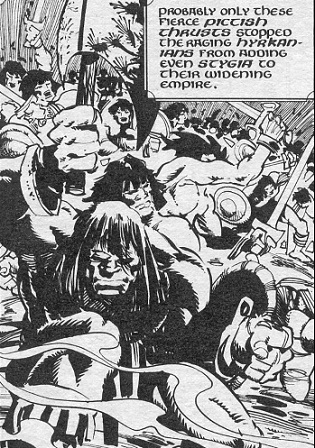 Classification: Human (Pictish ethnicity);
Classification: Human (Pictish ethnicity);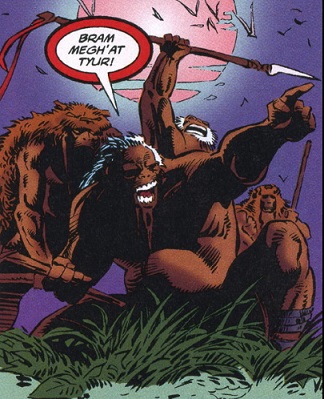
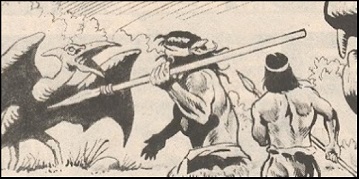 (Savage Sword of Conan I#104/2 (fb);
(Savage Sword of Conan I#104/2 (fb); 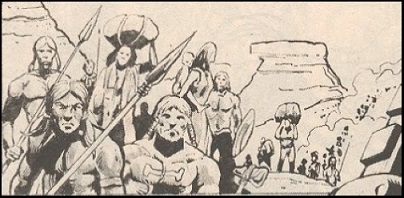 This savage race of humans had been warriors and hunters for
untold centuries, strong and of medium height, but swift and lean and
muscular like leopards, and were reputed as "the First Men." And after
thousands of years upon these isles of broad and fertile plains, this
warrior tribe clad in the hides of beasts and of crudely chipped stone
implements taught themselves the arts of peace, becoming skilled in
agriculture and harvesting grain and fruits, to polish their implements
of stone, to spin and weave and to build huts, and to become skilled in
the making of pottery and the working of pelts.
This savage race of humans had been warriors and hunters for
untold centuries, strong and of medium height, but swift and lean and
muscular like leopards, and were reputed as "the First Men." And after
thousands of years upon these isles of broad and fertile plains, this
warrior tribe clad in the hides of beasts and of crudely chipped stone
implements taught themselves the arts of peace, becoming skilled in
agriculture and harvesting grain and fruits, to polish their implements
of stone, to spin and weave and to build huts, and to become skilled in
the making of pottery and the working of pelts.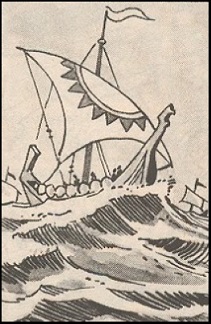
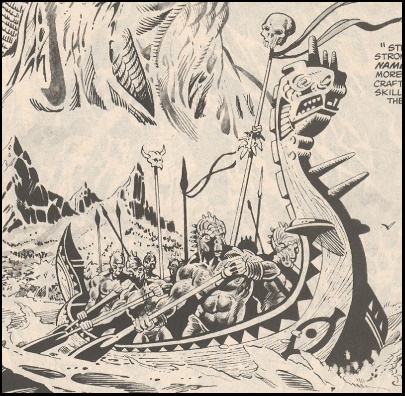
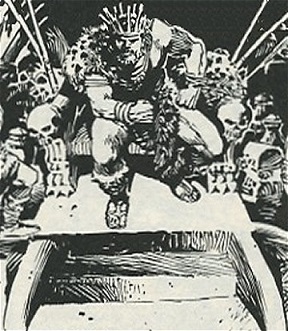 (
(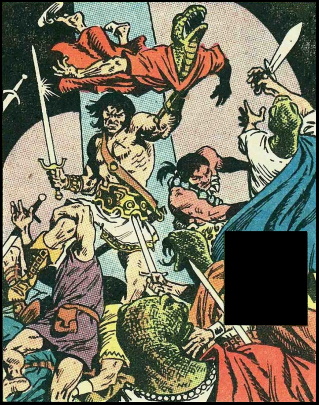
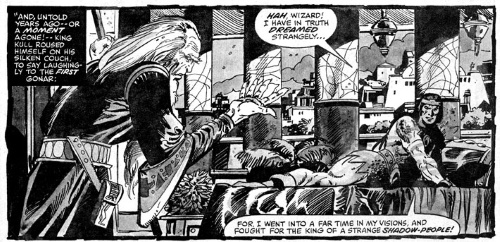 (Savage Sword of Conan I#42/2 - BTS, Savage Sword of Conan I#43/2
(fb)) <18,500 BC> - The Pictish shaman
(Savage Sword of Conan I#42/2 - BTS, Savage Sword of Conan I#43/2
(fb)) <18,500 BC> - The Pictish shaman 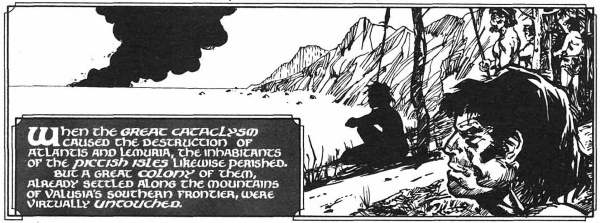 (Savage Sword of Conan I#8: The Hyborian Age, Chapter 2 - The Rise of
the Hyborians;
(Savage Sword of Conan I#8: The Hyborian Age, Chapter 2 - The Rise of
the Hyborians; 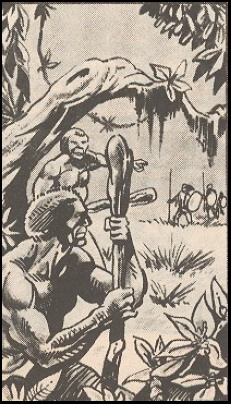 (Savage Sword of Conan I#104/2 (fb);
(Savage Sword of Conan I#104/2 (fb); 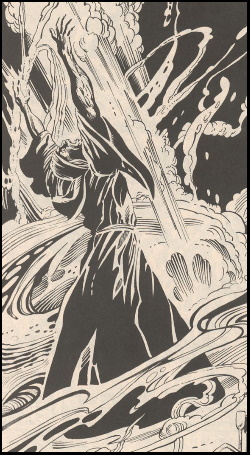
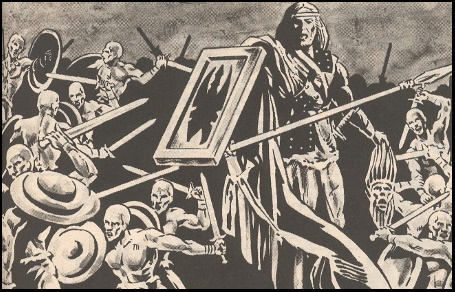 (Savage Sword of Conan I#69/2 (fb), Savage Sword of Conan I#104/2 (fb);
(Savage Sword of Conan I#69/2 (fb), Savage Sword of Conan I#104/2 (fb); 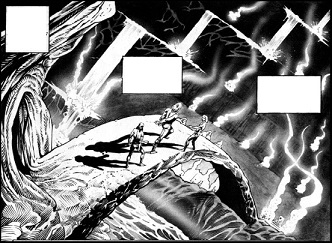 (Savage Sword of Conan I#68/2 - BTS, Savage Sword of Conan I#69/2 (fb);
(Savage Sword of Conan I#68/2 - BTS, Savage Sword of Conan I#69/2 (fb); 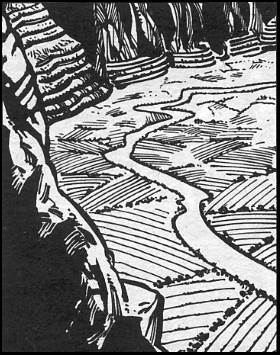 (Savage Sword of Conan I#12: The Hyborian Age, Chapter 3 - The
Hyborian Kingdoms;
(Savage Sword of Conan I#12: The Hyborian Age, Chapter 3 - The
Hyborian Kingdoms;  - A nomadic tribe of five hundred Aesir warriors
and their kin journeyed southward from Aesgaard, Nordheim into the
Pictish Wilderness. They briefly battled a tribe of Picts, but peace
was established through the efforts of the Aesir Niord and the Pict
- A nomadic tribe of five hundred Aesir warriors
and their kin journeyed southward from Aesgaard, Nordheim into the
Pictish Wilderness. They briefly battled a tribe of Picts, but peace
was established through the efforts of the Aesir Niord and the Pict
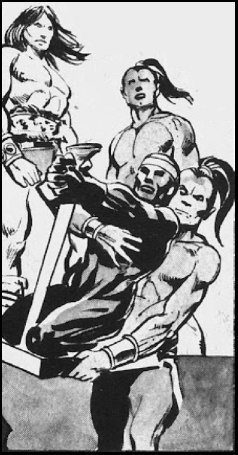 (Savage Tales#4, Sword of Conan II#6 - BTS) <10,000 BC> - Conan the Cimmerian sailed
across the stormy seven league lake in Vanaheim in pursuit of
(Savage Tales#4, Sword of Conan II#6 - BTS) <10,000 BC> - Conan the Cimmerian sailed
across the stormy seven league lake in Vanaheim in pursuit of 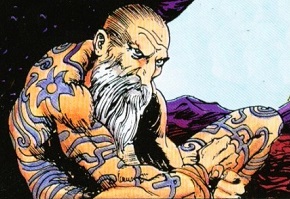 (Conan: The Ravagers Out of Time) <10,000 BC> - In northern
Turan, Conan the Cimmerian and Red Sonja of Hyrkania first encountered
the Pictish shaman
(Conan: The Ravagers Out of Time) <10,000 BC> - In northern
Turan, Conan the Cimmerian and Red Sonja of Hyrkania first encountered
the Pictish shaman 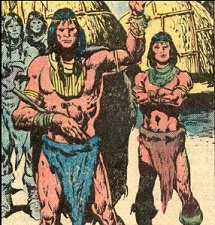
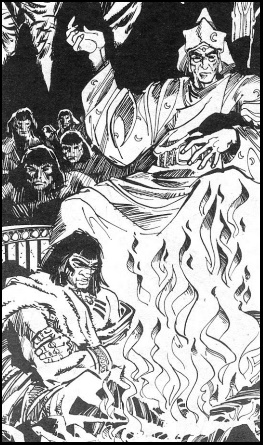 (Savage Sword of Conan I#15: The Hyborian Age, Chapter 4 - The
Beginning of the End, Savage Sword of Conan I#16: The Hyborian Age,
Chapter 5 - Fire and Slaughter;
(Savage Sword of Conan I#15: The Hyborian Age, Chapter 4 - The
Beginning of the End, Savage Sword of Conan I#16: The Hyborian Age,
Chapter 5 - Fire and Slaughter; 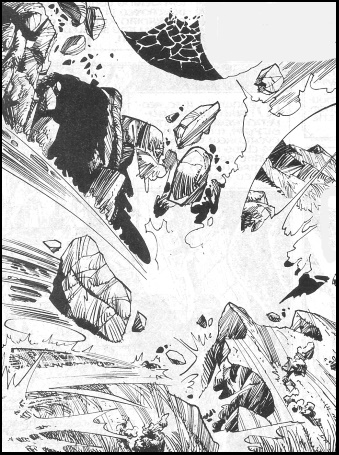 (Savage Sword of Conan I#17: The Hyborian Age, Chapter 6 - The
Darkness... and the Dawn;
(Savage Sword of Conan I#17: The Hyborian Age, Chapter 6 - The
Darkness... and the Dawn; 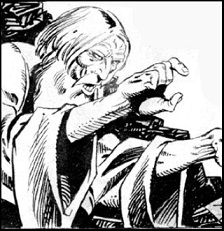 (Historical accounts) <122 AD> - The construction of Hadrian's
Wall (Vallum Aelium in Latin), also known as the Roman Wall or Picts'
Wall, a defensive fortification of the Roman province of Britannia,
started during the reign of Emperor Hadrian. The length of the Wall was
80 Roman miles (or 73 modern miles), covering the entire width of the
island from the town Bowness-on-Solway in the west to the town Wallsend
on Tyne on the River Tyne in the east. The Wall was intended for use as
a strong defensive barrier to protect the Roman conquered lands to the
south from the barbarian tribes to the north.
(Historical accounts) <122 AD> - The construction of Hadrian's
Wall (Vallum Aelium in Latin), also known as the Roman Wall or Picts'
Wall, a defensive fortification of the Roman province of Britannia,
started during the reign of Emperor Hadrian. The length of the Wall was
80 Roman miles (or 73 modern miles), covering the entire width of the
island from the town Bowness-on-Solway in the west to the town Wallsend
on Tyne on the River Tyne in the east. The Wall was intended for use as
a strong defensive barrier to protect the Roman conquered lands to the
south from the barbarian tribes to the north.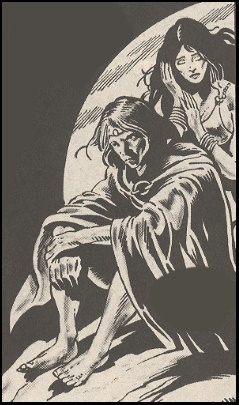
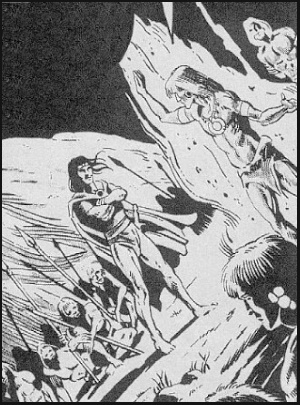
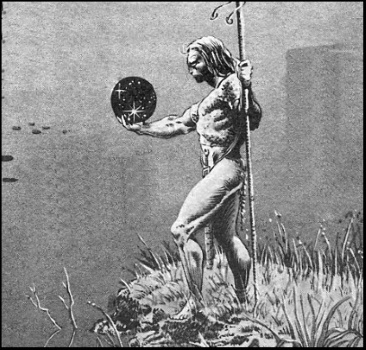
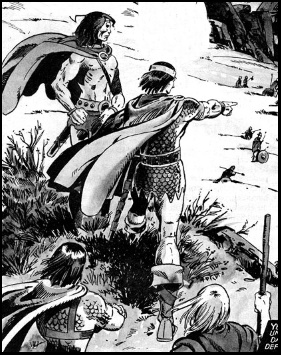 (Savage Sword of Conan I#42/2 - BTS) <207 AD> - Northmen from
Norway raided the countries of the south in their galleys, ravaging the
coasts and burning villages of the Picts of Caledon. Bran Mak Morn
burned their longships and ambushed the Northmen, and he threatened to cut
them down with thrice their number of bowmen hidden in the forested
hills. He spared them when the Northman leader
(Savage Sword of Conan I#42/2 - BTS) <207 AD> - Northmen from
Norway raided the countries of the south in their galleys, ravaging the
coasts and burning villages of the Picts of Caledon. Bran Mak Morn
burned their longships and ambushed the Northmen, and he threatened to cut
them down with thrice their number of bowmen hidden in the forested
hills. He spared them when the Northman leader 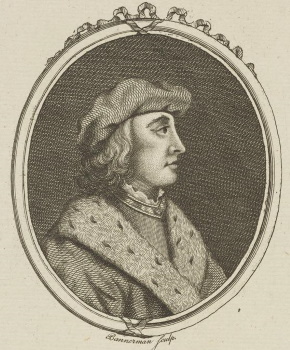 (Historical accounts) <9th Century AD> - Kenneth MacAlpin (also
known as Cinaed mac Ailpin) was born circa 810 AD, and upon the death
of his father Alpin mac Echdach, Kenneth succeeded him as the King of
Dal Riada in 841 AD. The son on a Pictish princess, Kenneth then
undertook the conquest of the Picts, annexing Pictavia into the nation
of Alba (modern Scotland) and reigning from 843 to 858 AD.
(Historical accounts) <9th Century AD> - Kenneth MacAlpin (also
known as Cinaed mac Ailpin) was born circa 810 AD, and upon the death
of his father Alpin mac Echdach, Kenneth succeeded him as the King of
Dal Riada in 841 AD. The son on a Pictish princess, Kenneth then
undertook the conquest of the Picts, annexing Pictavia into the nation
of Alba (modern Scotland) and reigning from 843 to 858 AD.
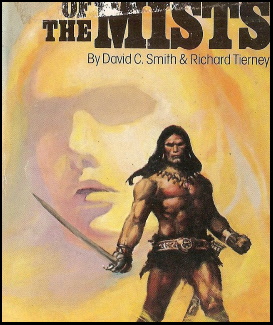 Aeysla, also known as the Great Mother, Moon Woman, Moon-Mother, Witch-Queen of
Atlantis and Witch of the Mists, was daughter of the Pictish moon god
Aeysla, also known as the Great Mother, Moon Woman, Moon-Mother, Witch-Queen of
Atlantis and Witch of the Mists, was daughter of the Pictish moon god 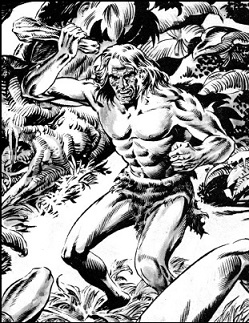
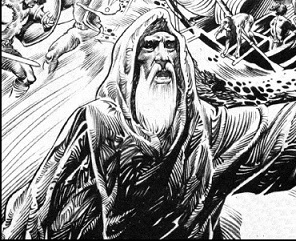
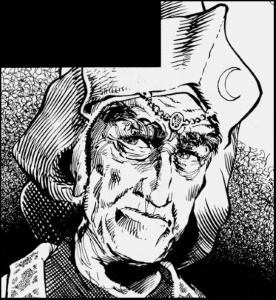 Arus was a Nemedian reformer and devout follower of the god of light and justice
Arus was a Nemedian reformer and devout follower of the god of light and justice 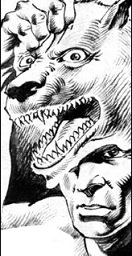
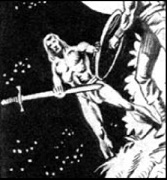 Berula was a chieftain amongst the diminutive Alban
Picts in first century BC Cornwall. When venturing outside of their cavernous
abode, Berula often wore a realistic wolf skin and mimicked wolfish movements
like walking on all fours, convincing observers he was an actual wolf. At times
however, he would also walk on two legs or seemingly vanish by leaping into the
branches of nearby trees, causing some to believe him a werewolf.
Berula was a chieftain amongst the diminutive Alban
Picts in first century BC Cornwall. When venturing outside of their cavernous
abode, Berula often wore a realistic wolf skin and mimicked wolfish movements
like walking on all fours, convincing observers he was an actual wolf. At times
however, he would also walk on two legs or seemingly vanish by leaping into the
branches of nearby trees, causing some to believe him a werewolf. 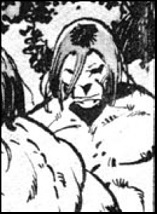
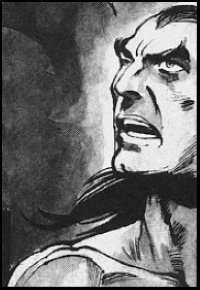
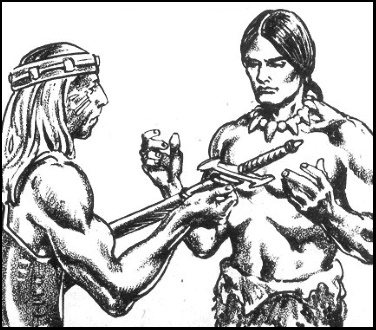
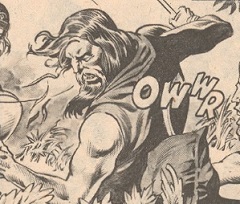 BURUC THE CRUEL
BURUC THE CRUEL